Study to Determine Levels of Cadmium in Cocoa Crops Applied to Inland Areas of Peru: “The Case of the Campo Verde-Honoria Tournavista Corridor”
Abstract
1. Introduction
2. Materials and Methods
2.1. Study Area Location
2.2. Study Area
2.3. Collection and Processing of Soils and Cocoa Fruits
2.3.1. Soil and Cocoa Fruit Sampling
2.3.2. Sample Processing
2.3.3. Chemical Analysis of Samples
2.3.4. Atomic Absorption Analysis
3. Results and Discussion
4. Conclusions
Author Contributions
Funding
Conflicts of Interest
Abbreviations
| MDPI | Multidisciplinary Digital Publishing Institute |
| DOAJ | Directory of open access journals |
| TLA | Three letter acronym |
| LD | linear dichroism |
References
- Aikpokpodion Paul, E. Assessment of heavy metals pollution in fungicide treated Cocoa plantations in Ondo state, Nigeria. J. Appl. Biosci. 2010, 33, 2037–2046. [Google Scholar]
- Senesil, G.S.; Baldassarre, G.; Senesi, N.; Radina, B. Trace element inputs into soils by anthropogenic activities and implications for human health. Chemosphere 1999, 39, 343–377. [Google Scholar] [CrossRef]
- Ross, S.M. Sources and forms of potentially toxic metals in soil-plant systems. In Toxic Metals in Soil-Plant Systems; Wiley: Chichester, UK, 1994; pp. 3–26. [Google Scholar]
- Alloway, J. Soil pollution and land contamination. In Pollution: Causes, Effects and Control; Harrison, R.M., Ed.; The Royal Society of Chemistry: Cambridge, UK, 1995; p. 318. [Google Scholar]
- Méndez, J.P.; Ramírez, C.A.G.; Gutiérrez, A.D.R.; García, F.P. Contaminación y fitotoxicidad en plantas por metales pesados provenientes de suelos y agua. Trop. Subtrop. Agroecosyst. 2009, 10, 29–44. [Google Scholar]
- Takrama, J.; Afrifa, A.A.; Ofori-Frimpong, K.; Jonfia-Essien, W.A.; Agyemang, P.; Galyuon, I. Cadmium contamination of cocoa beans and cocoa growing agricultural soils of Ghana: There is no cause for public alarm. Peak J. Public Health Manag. 2015, 3, 56–61. [Google Scholar]
- Cadmium in the Human Environment: Toxicity and Carcinogenicity. Available online: https://publications.iarc.fr/Book-And-Report-Series/Iarc-Scientific-Publications/Cadmium-In-The-Human-Environment-Toxicity-And-Carcinogenicity-1992 (accessed on 3 February 2020).
- Agents. Available online: https://monographs.iarc.fr/agents-classified-by-the-iarc/ (accessed on 3 February 2020).
- Alves Peixoto, R.R.; Oliveira, A.; Cadore, S. Risk assessment of cadmium and chromium from chocolate powder. Food Addit. Contam. Part B 2018, 11, 256–263. [Google Scholar] [CrossRef] [PubMed]
- Puga, S.; Sosa, M.; Lebgue, T.; Quintana, C.; Campos, A. Heavy metals pollution in soils damaged by mining industry. Ecol. Apl. 2006, 5, 149–155. [Google Scholar] [CrossRef]
- Alloway, B.J. Heavy Metals in Soils: Trace Metals and Metalloids in Soils and Their Bioavailability; Springer: Berlin, Germany, 2012; Volume 22. [Google Scholar]
- Violante, A.; Cozzolino, V.; Perelomov, L.; Caporale, A.; Pigna, M. Mobility and bioavailability of heavy metals and metalloids in soil environments. J. Soil Sci. Plant Nutr. 2010, 10, 268–292. [Google Scholar] [CrossRef]
- Lago Vila, M. Biodisponibilidad de Metales Pesados en Suelos Contaminados. Ph.D. Thesis, Bioloxía Vexetal e Ciencias do Solo, Universidad de Vigo, Vigo, Spain, 2019. [Google Scholar]
- McLaughlin, M.J.; Singh, B.R. Cadmium in soils and plants. In Cadmium in Soils and Plants; Springer: Berlin, Germany, 1999; pp. 1–9. [Google Scholar]
- Arévalo-Gardini, E.; Obando-Cerpa, M.E.; Zúñiga-Cernades, L.B.; Arévalo-Hernández, C.O.; Baligar, V.; He, Z. Metales pesados en suelos de plantaciones de cacao (Theobroma cacao L.) en tres regiones del Perú. Ecol. Appl. 2016, 15, 81–89. [Google Scholar] [CrossRef]
- Amankwaah, D.; Nnuro, W.; Awudza, J.; Afful, S. Determination of heavy metals in cocoa beans from some major cocoa growing regions in Ghana. Food Sci. Technol. 2015, 16, 225. [Google Scholar]
- Chavez, E.; He, Z.; Stoffella, P.; Mylavarapu, R.; Li, Y.; Moyano, B.; Baligar, V. Concentration of cadmium in cacao beans and its relationship with soil cadmium in southern Ecuador. Sci. Total Environ. 2015, 533, 205–214. [Google Scholar] [CrossRef]
- HuamanI-Yupanqui, H.A.; Ángel Huauya-Rojas, M.; Mansilla-Minaya, L.G.; Florida-Rofner, N.; Neira-Trujillo, G.M. Presencia de metales pesados en cultivo de cacao (Theobroma cacao L.) orgánico. Acta Agron. 2012, 61, 339–344. [Google Scholar]
- Gramlich, A.; Tandy, S.; Gauggel, C.; López, M.; Perla, D.; Gonzalez, V.; Schulin, R. Soil cadmium uptake by cocoa in Honduras. Sci. Total Environ. 2018, 612, 370–378. [Google Scholar] [CrossRef]
- Llatance, W.O.; Saavedra, C.J.G.; Castillo, W.G.; Mondragón, E.P. Bioacumulación de cadmio en el cacao (Theobroma cacao) en la Comunidad Nativa de Pakun, Perú. Rev. For. Perú 2018, 33, 63–75. [Google Scholar] [CrossRef]
- Casteblanco, J.A. Técnicas de remediación de metales pesados con potencial aplicación en el cultivo de cacao. LA GRANJA. Revista de Ciencias de la Vida 2018, 27, 21–35. [Google Scholar] [CrossRef]
- Abt, E.; Fong Sam, J.; Gray, P.; Robin, L.P. Cadmium and lead in cocoa powder and chocolate products in the US Market. Food Addit. Contam. Part B 2018, 11, 92–102. [Google Scholar] [CrossRef]
- Rascio, N.; Navari-Izzo, F. Heavy metal hyperaccumulating plants: How and why do they do it? And what makes them so interesting? Plant Sci. 2011, 180, 169–181. [Google Scholar] [CrossRef]
- Argüello, D.; Chavez, E.; Lauryssen, F.; Vanderschueren, R.; Smolders, E.; Montalvo, D. Soil properties and agronomic factors affecting cadmium concentrations in cacao beans: A nationwide survey in Ecuador. Sci. Total Environ. 2019, 649, 120–127. [Google Scholar] [CrossRef]
- Gramlich, A.; Tandy, S.; Andres, C.; Paniagua, J.C.; Armengot, L.; Schneider, M.; Schulin, R. Cadmium uptake by cocoa trees in agroforestry and monoculture systems under conventional and organic management. Sci. Total Environ. 2017, 580, 677–686. [Google Scholar] [CrossRef]
- Zug, K.L.M.; Yupanqui, H.A.H.; Meyberg, F.; Cierjacks, J.S.; Cierjacks, A. Cadmium accumulation in Peruvian cacao (Theobroma cacao L.) and opportunities for mitigation. Water Air Soil Pollut. 2019, 230, 72. [Google Scholar] [CrossRef]
- Arévalo-Gardini, E.; Arévalo-Hernández, C.O.; Baligar, V.C.; He, Z.L. Heavy metal accumulation in leaves and beans of cacao (Theobroma cacao L.) in major cacao growing regions in Peru. Sci. Total Environ. 2017, 605, 792–800. [Google Scholar] [CrossRef]
- Sánchez Rodríguez, M. Evaluación del Contenido de Metales Pesados (cd y pb) en Diferentes Edades y Etapas Fenológicas del Cultivo de Cacao en dos Zonas del Alto, Huallaga. 2017. Available online: http://repositorio.unas.edu.pe/handle/UNAS/1299 (accessed on 3 February 2020).
- Resolucion Ministerial 449. 2018. Available online: http://minagri.gob.pe/portal/download/pdf/normas-legales/resolucionesministeriales/2018/noviembre/rm449-2018-minagri.pdf (accessed on 3 February 2020).
- Guia de Manejo Fitosanitario y la Inocuidad en el Cacaotal. 2017. Available online: http://repositorio.iica.int/bitstream/handle/11324/6456/BVE18029639e.pdf;jsessionid=167C0B852C59B94ACBF924E1EB010489?sequence=1 (accessed on 3 February 2020).
- Anyimah-Ackah, E.; Ofosu, I.W.; Lutterodt, H.E.; Darko, G. Exposures and risks of arsenic, cadmium, lead, and mercury in cocoa beans and cocoa-based foods: A systematic review. Food Qual. Saf. 2019, 3, 1–8. [Google Scholar] [CrossRef]
- Sabroso, M.; Pastor, A. Guía sobre suelos Contaminados; CEPYME Aragon y Gobierno de Aragon: Zaragoza, Spain, 2004; Available online: https://www.academia.edu/29109561/Gu%C3%ADa_sobre_suelos_contaminados (accessed on 3 February 2020).
- MINAM. Available online: http://www.minam.gob.pe/calidadambiental/wp-content/uploads/sites/22/2013/10/GUIA-PARA-EL-MUESTREO-DE-SUELOS-final.pdf (accessed on 3 February 2020).
- Nigam, R.; Srivastava, S.; Prakash, S.; Srivastava, M. Cadmium mobilisation and plant availability— The impact of organic acids commonly exuded from roots. Plant Soil 2001, 230, 107–113. [Google Scholar] [CrossRef]
- United States Environmental Protection Agency. Method 3050B. Acid Digestion of Sediments, Sludges, and Soils; Revision 2; U.S. EPA: Washington, DC, USA, 1996; Volume 2, pp. 1–12.
- Isaac, R.A.; Johnson, W.C. Collaborative study of wet and dry ashing techniques for the elemental analysis of plant tissue by atomic absorption spectrophotometry. J. Assoc. Off. Anal. Chem. 1975, 58, 436–440. [Google Scholar] [CrossRef]
- ArcGIS Pro, Software. Available online: https://www.esri.com/es-es/arcgis/products/arcgis-pro/overview (accessed on 3 February 2020).
- Decreto Supremo 002-2013 MINAM. Available online: https://fonamperu.org.pe/un-fondo-ambiental-para-el-peru/download/decreto-supremo-n-002-2013-minam/ (accessed on 3 February 2020).
- R Software. Available online: https://www.r-project.org/ (accessed on 3 February 2020).
- Reglamento Union Europea 488. 2014. Available online: https://eur-lex.europa.eu/legal-content/ES/TXT/PDF/?uri=CELEX:32014R0488&from=SL/ (accessed on 3 February 2020).
- Cieśliński, G.; Van Rees, K.; Huang, P.; Kozak, L.; Rostad, H.; Knott, D. Cadmium uptake and bioaccumulation in selected cultivars of durum wheat and flax as affected by soil type. Plant Soil 1996, 182, 115–124. [Google Scholar] [CrossRef]
- McGrath, S.; Zhao, F.; Dunham, S.; Crosland, A.; Coleman, K. Long-term changes in the extractability and bioavailability of zinc and cadmium after sludge application. J. Environ. Qual. 2000, 29, 875–883. [Google Scholar] [CrossRef]
- Resolucion Ministerial 0451. 2018. Available online: http://minagri.gob.pe/portal/resoluciones-ministeriales/rm-2018/22560-resolucion-ministerial-n-0451-2018-minagri-2 (accessed on 3 February 2020).
- Lê, S.; Josse, J.; Husson, F. FactoMineR: An R package for multivariate analysis. J. Stat. Softw. 2008, 25, 1–18. [Google Scholar] [CrossRef]
- Gabriel, K.R.; Odoroff, C.L. Biplots in biomedical research. Stat. Med. 1990, 9, 469–485. [Google Scholar] [CrossRef]
- Gower, J.C.; Lubbe, S.G.; Le Roux, N.J. Understanding Biplots; John Wiley & Sons: Hoboken, NJ, USA, 2011. [Google Scholar]
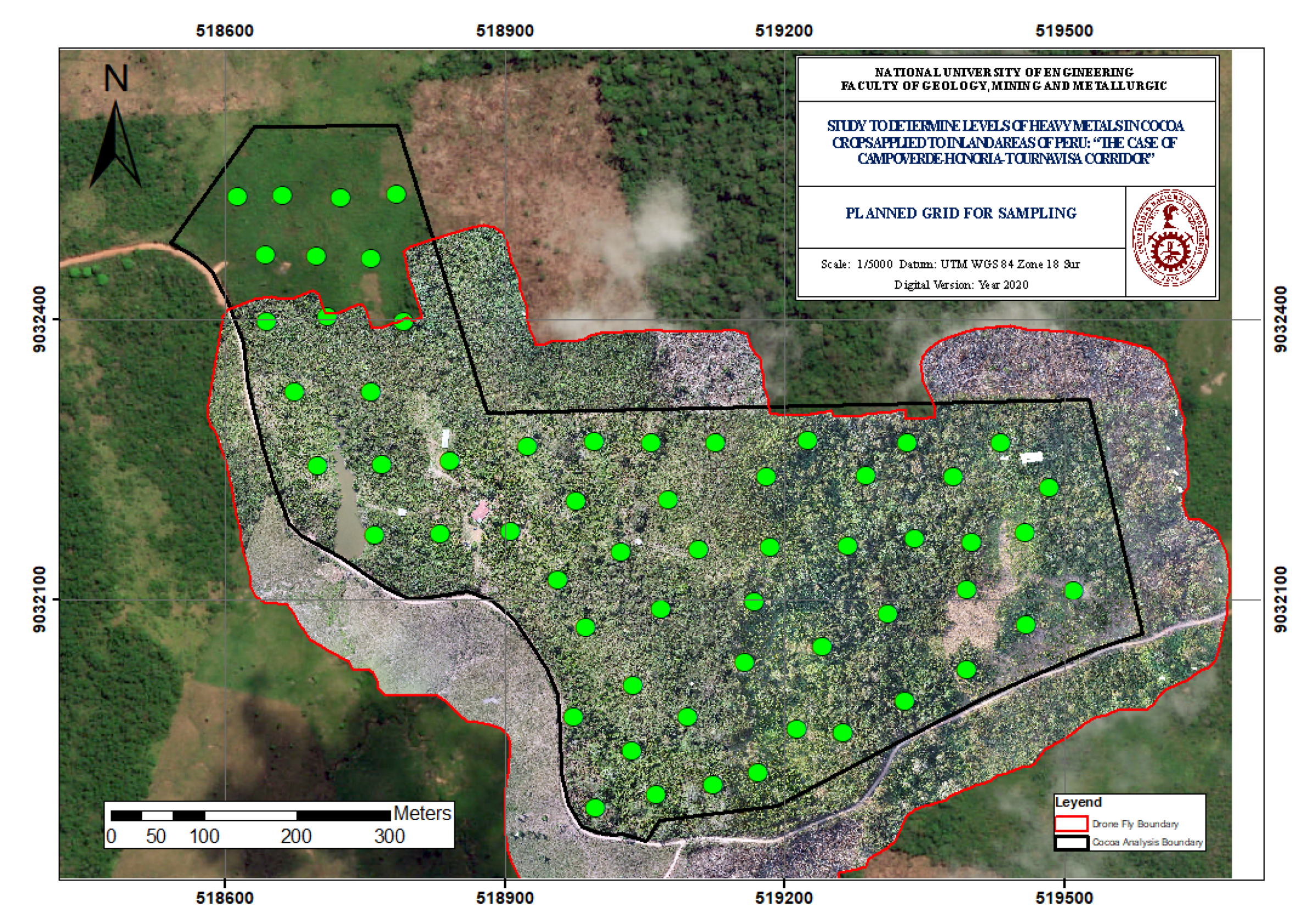
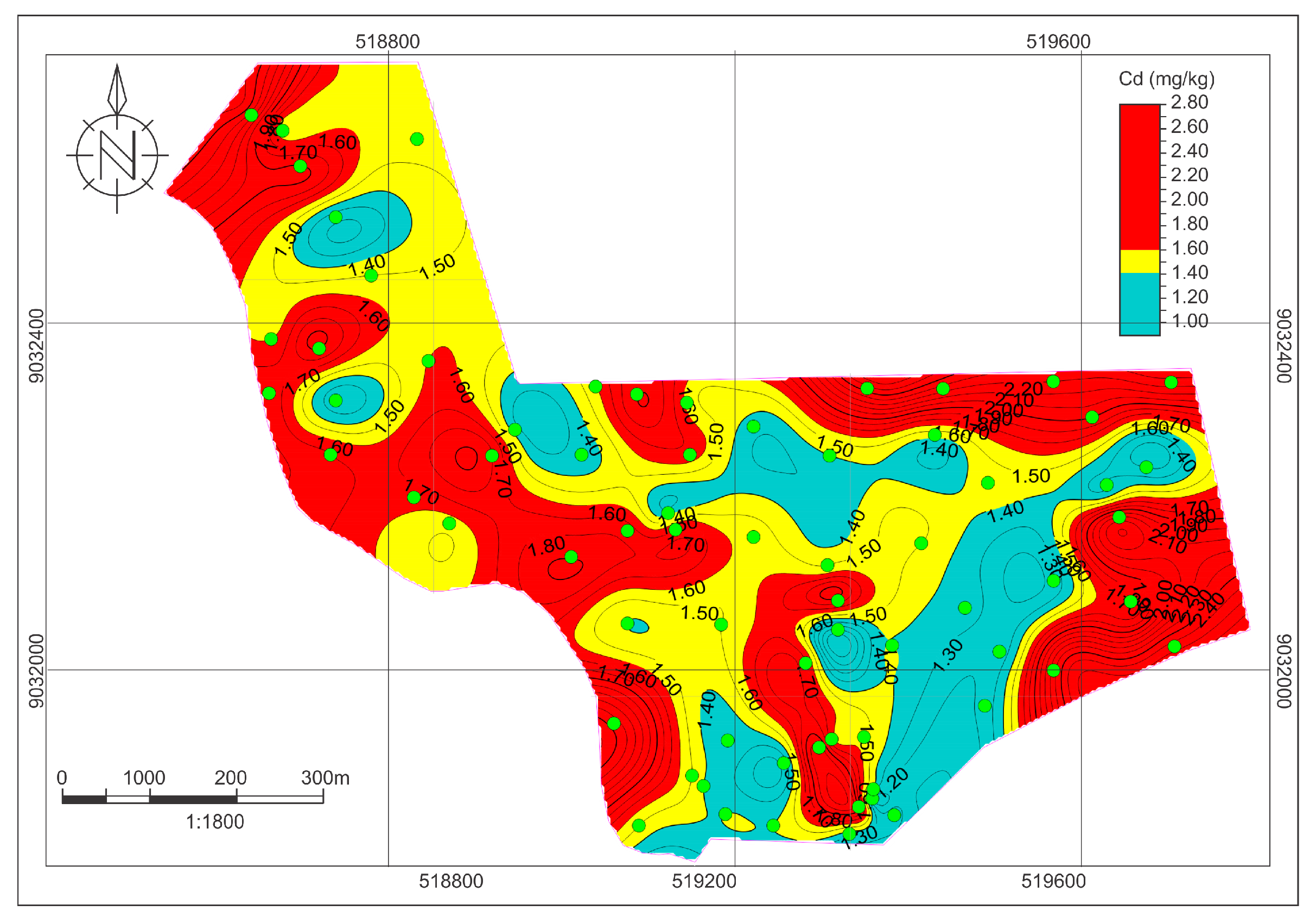
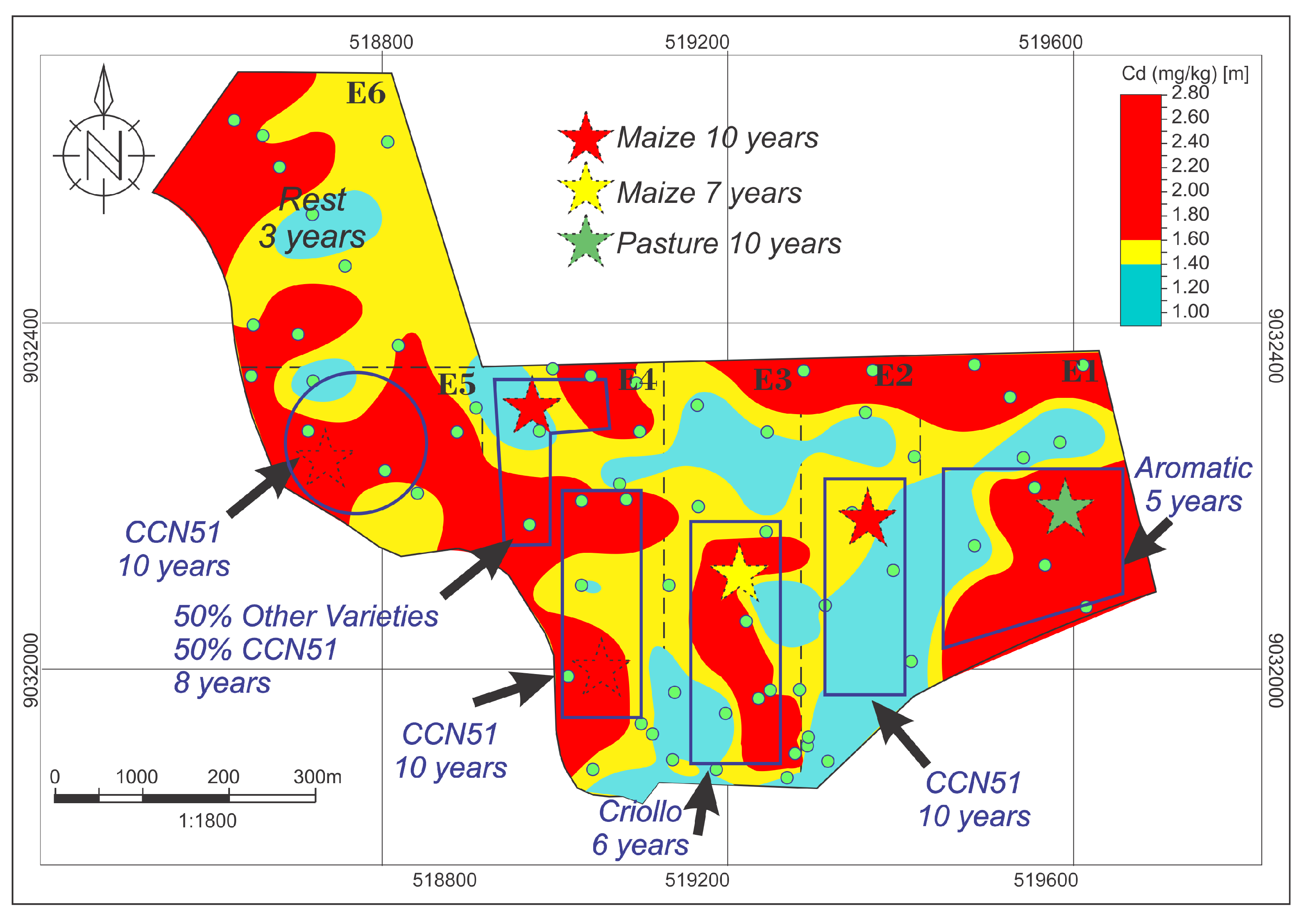
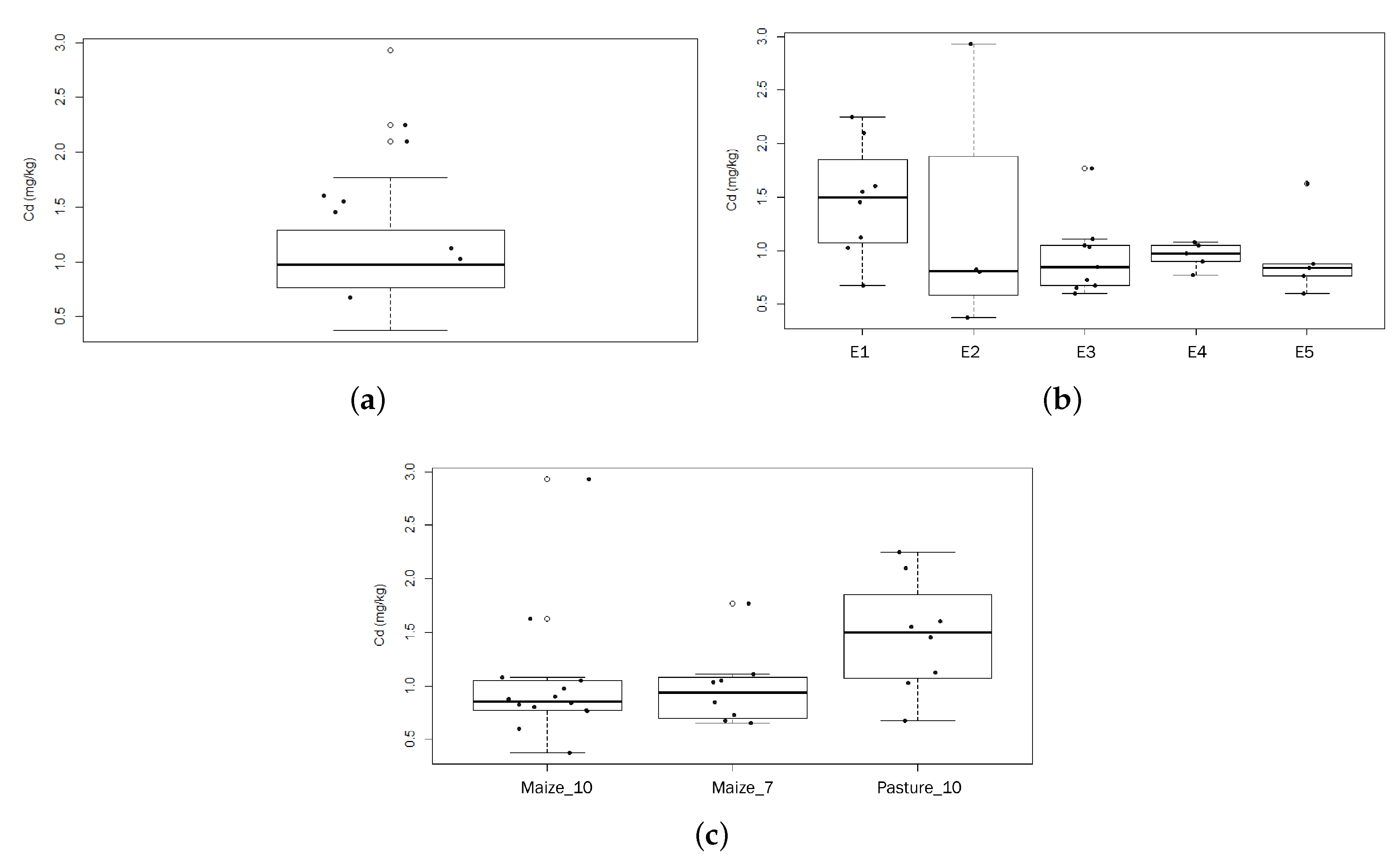
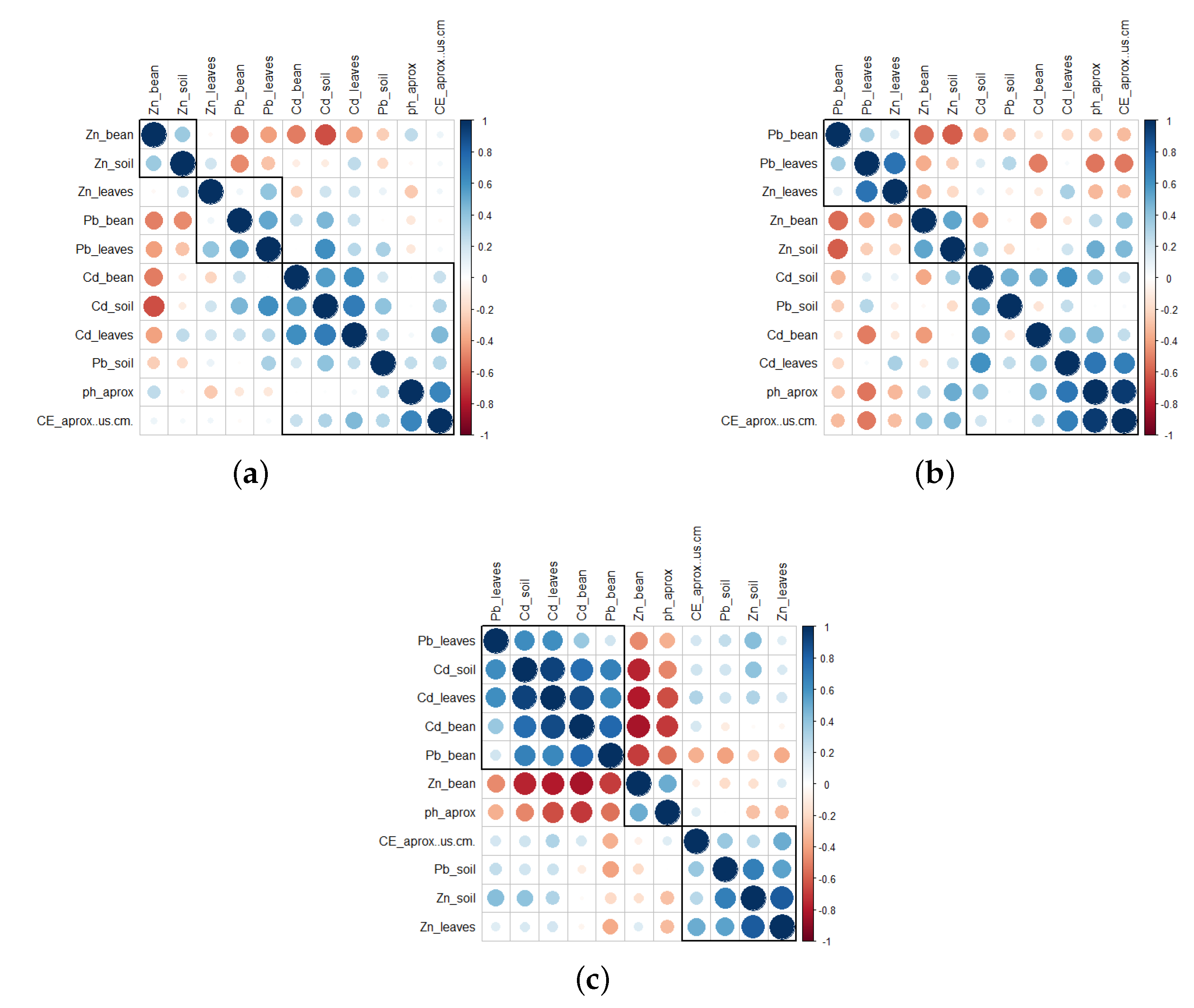
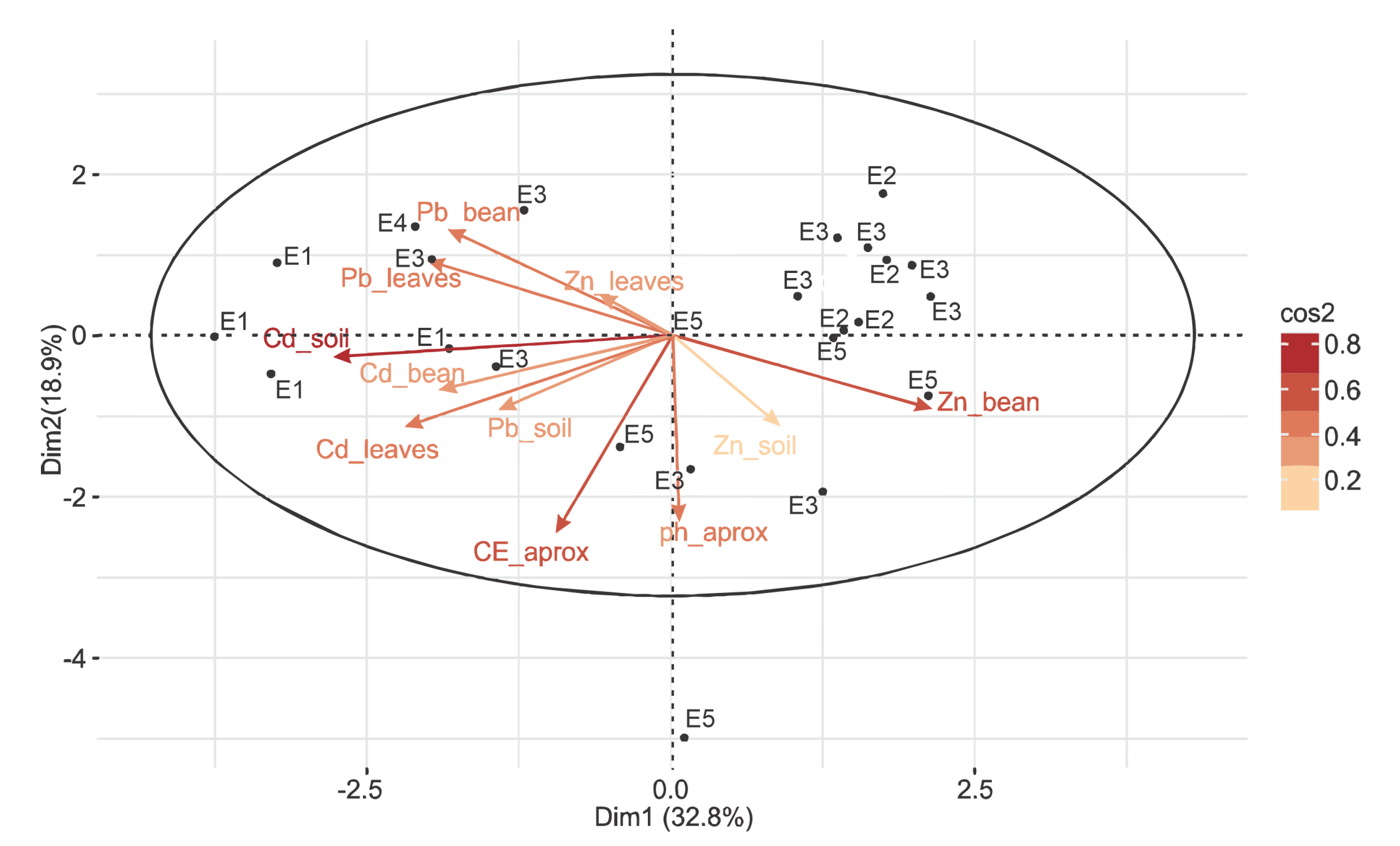
| Factors | Effect of Absorption of Cadmium by Plants |
|---|---|
| Edaphic Factors | |
| pH | The absorption process increases at a lower pH, that is, it is greater in acidic soils. |
| Soil Salinity | Cadmium absorption increases with soil salinity. |
| Cadmium Concentration | Absorption increases with increasing cadmium concentration. |
| Micronutrients | The absorption process is variable according to the nature and quantity of micronutrients. |
| Macronutrients | The absorption process is variable according to the nature and quantity of macronutrients. |
| Temperature | The absorption increases with increasing temperature. |
| Crop Factors | |
| Arable Species | The absorption process of heavy metals decreases according to the following trend: |
| Vegetables> beans> cereals> fruits. | |
| Plant Tissue | Leaf> bean> edible fruits and roots. |
| Sheet Age | Old leaves> young leaves. |
| X | Y | Cd (mg/kg) | Pb (mg/kg) | Zn (mg/kg) | pH | CE (uS/cm) |
|---|---|---|---|---|---|---|
| 518,642.00 | 9,032,291.00 | 1.75 | 5.41 | 70.55 | 7.06 | 39.94 |
| 518,644.00 | 9,032,343.00 | 1.60 | 5.03 | 99.40 | 6.55 | 10.30 |
| 518,690.00 | 9,032,334.00 | 1.90 | 7.24 | 77.12 | 6.28 | 5.00 |
| 518,701.00 | 9,032,232.00 | 1.70 | 5.81 | 97.10 | 8.00 | 126.69 |
| 518,706.00 | 9,032,284.00 | 1.25 | 5.91 | 74.70 | 6.70 | 8.00 |
| 518,986.00 | 9,032,159.00 | 1.75 | 5.62 | 58.15 | 6.40 | 8.70 |
| 519,048.00 | 9,031,924.00 | 1.50 | 6.57 | 82.95 | 6.53 | 15.00 |
| 519,059.00 | 9,031,914.00 | 1.40 | 5.26 | 68.30 | 5.79 | 5.00 |
| 519,080.00 | 9,031,887.00 | 1.40 | 5.01 | 70.95 | 5.41 | 4.50 |
| 519,082.00 | 9,031,958.00 | 1.35 | 7.02 | 58.70 | 6.39 | 18.01 |
| 519,170.00 | 9,031,951.00 | 2.05 | 6.37 | 30.15 | 6.46 | 9.00 |
| 519,178.00 | 9,032,126.00 | 1.50 | 7.18 | 38.90 | 7.92 | 52.25 |
| 519,188.00 | 9,032,064.00 | 1.10 | 4.81 | 11.80 | 6.95 | 30.00 |
| 519,188.00 | 9,032,092.00 | 1.85 | 6.37 | 30.05 | 7.50 | 40.28 |
| 519,199.00 | 9,031,868.00 | 1.35 | 5.09 | 46.75 | 6.13 | 9.00 |
| 519,208.00 | 9,031,894.00 | 1.90 | 5.41 | 48.40 | 6.20 | 10.40 |
| 519,213.00 | 9,031,961.00 | 1.55 | 4.74 | 91.15 | 6.26 | 14.00 |
| 519,221.00 | 9,031,902.00 | 1.10 | 5.21 | 58.70 | 6.17 | 12.00 |
| 519,222.00 | 9,031,911.00 | 1.35 | 5.89 | 61.70 | 6.18 | 13.00 |
| 519,242.00 | 9,031,886.00 | 1.25 | 5.64 | 54.23 | 6.07 | 11.50 |
| 519,395.00 | 9,032,025.00 | 2.25 | 5.94 | 27.80 | 6.06 | 26.90 |
| 519,469.00 | 9,032,091.00 | 1.70 | 7.23 | 38.60 | 6.51 | 43.14 |
| 519,511.00 | 9,032,048.00 | 2.55 | 6.51 | 64.35 | 6.36 | 47.00 |
| 519,556.00 | 9,032,093.00 | 2.11 | 7.02 | 47.35 | 5.98 | 66.94 |
| Summary Statistics | Cd | Pb | Zn | Cd | Pb | Zn | Cd | Pb | Zn | pH | CE (uS/cm) |
|---|---|---|---|---|---|---|---|---|---|---|---|
| CCN51 | |||||||||||
| Mean | 0.86 | 1.73 | 79.03 | 1.59 | 5.62 | 76.73 | 2.27 | 2.09 | 112.11 | 6.61 | 28.70 |
| Standard deviation | 0.36 | 0.83 | 10.47 | 0.26 | 0.76 | 17.20 | 0.65 | 0.43 | 24.36 | 0.63 | 41.01 |
| Coefficient of variability | 42% | 48% | 13% | 16% | 14% | 22% | 29% | 21% | 22% | 10% | 143% |
| CREOLE-AROMATIC | |||||||||||
| Mean | 1.07 | 2.10 | 69.72 | 1.83 | 6.49 | 38.63 | 2.08 | 2.45 | 102.25 | 6.68 | 37.06 |
| Standard deviation | 0.33 | 0.65 | 12.28 | 0.46 | 0.77 | 16.29 | 0.82 | 0.56 | 40.10 | 0.65 | 17.93 |
| Coefficient of variability | 31% | 31% | 18% | 25% | 12% | 42% | 39% | 23% | 39% | 10% | 48% |
| TOTAL | |||||||||||
| Mean | 0.96 | 1.72 | 74.41 | 1.63 | 5.93 | 58.66 | 2.10 | 2.15 | 104.49 | 6.49 | 26.11 |
| Standard deviation | 0.34 | 0.74 | 11.39 | 0.37 | 0.81 | 22.63 | 0.69 | 0.54 | 32.19 | 0.62 | 27.66 |
| Coefficient of variability | 35% | 43% | 15% | 22% | 14% | 39% | 33% | 25% | 31% | 9% | 106% |
| Sample Mean | Cd Soils | Sample Size | Variance | SCl | |
|---|---|---|---|---|---|
| Lower | Upper | ||||
| Total (E1, E2, E3, E4, E5) | 1.63 | 24 | 0.135 | 1.44 | 1.83 |
| Total without E1 | 1.53 | 20 | 0.076 | 1.35 | 1.71 |
| Intensity of Land Use | |||||
| Maize 7 years | 1.55 | 8 | 0.113 | 1.09 | 2.01 |
| Maize 10 years | 1.59 | 8 | 0.065 | 1.23 | 1.94 |
| Pasture 10 years | 2.81 | 4 | 1.792 | - | - |
Publisher’s Note: MDPI stays neutral with regard to jurisdictional claims in published maps and institutional affiliations. |
© 2020 by the authors. Licensee MDPI, Basel, Switzerland. This article is an open access article distributed under the terms and conditions of the Creative Commons Attribution (CC BY) license (http://creativecommons.org/licenses/by/4.0/).
Share and Cite
Rosales-Huamani, J.A.; Breña-Ore, J.L.; Sespedes-Varkarsel, S.; Huamanchumo de la Cuba, L.; Centeno-Rojas, L.; Otiniano-Zavala, A.; Andrade-Choque, J.; Valverde-Espinoza, S.; Castillo-Sequera, J.L. Study to Determine Levels of Cadmium in Cocoa Crops Applied to Inland Areas of Peru: “The Case of the Campo Verde-Honoria Tournavista Corridor”. Agronomy 2020, 10, 1576. https://doi.org/10.3390/agronomy10101576
Rosales-Huamani JA, Breña-Ore JL, Sespedes-Varkarsel S, Huamanchumo de la Cuba L, Centeno-Rojas L, Otiniano-Zavala A, Andrade-Choque J, Valverde-Espinoza S, Castillo-Sequera JL. Study to Determine Levels of Cadmium in Cocoa Crops Applied to Inland Areas of Peru: “The Case of the Campo Verde-Honoria Tournavista Corridor”. Agronomy. 2020; 10(10):1576. https://doi.org/10.3390/agronomy10101576
Chicago/Turabian StyleRosales-Huamani, Jimmy Aurelio, Jorge Luis Breña-Ore, Svitlana Sespedes-Varkarsel, Luis Huamanchumo de la Cuba, Luis Centeno-Rojas, Alonso Otiniano-Zavala, Joseps Andrade-Choque, Santiago Valverde-Espinoza, and Jose Luis Castillo-Sequera. 2020. "Study to Determine Levels of Cadmium in Cocoa Crops Applied to Inland Areas of Peru: “The Case of the Campo Verde-Honoria Tournavista Corridor”" Agronomy 10, no. 10: 1576. https://doi.org/10.3390/agronomy10101576
APA StyleRosales-Huamani, J. A., Breña-Ore, J. L., Sespedes-Varkarsel, S., Huamanchumo de la Cuba, L., Centeno-Rojas, L., Otiniano-Zavala, A., Andrade-Choque, J., Valverde-Espinoza, S., & Castillo-Sequera, J. L. (2020). Study to Determine Levels of Cadmium in Cocoa Crops Applied to Inland Areas of Peru: “The Case of the Campo Verde-Honoria Tournavista Corridor”. Agronomy, 10(10), 1576. https://doi.org/10.3390/agronomy10101576









